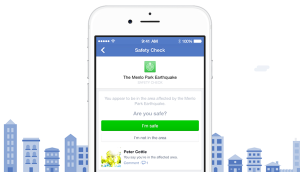Social Media-ting a Crisis
Posted on December 10, 2015, at 7:00 p.m.
by Madalyn Atherton.
“If the citizens of Pompeii, before they were consumed by fire, had a chance to tell their friends and family throughout Rome, ‘I love you,’ ‘I’m scared,’ ‘Don’t forget me,’ don’t you think they’d have taken the chance?”
This is an excerpt of a poem by Tumblr user herrsassyfras. It also helps to explain the rise and widespread effect of social media during crisis communications efforts in tragedy-stricken areas. Older generations scoff at the use of social media but, as cheesy as it sounds, it does serve the very important purpose of connecting the world. Instead of learning about tragedies the day after and hoping the phone lines are working so people can contact their loved ones, social media and the 24-hour news cycle keep us all connected and informed. With a few taps on a phone or keyboard, anyone with Wi-Fi can know that their loved ones are safe.
Facebook launched the Safety Check feature in 2014 in Japan, but it got nationwide media attention during the terrorist attacks on Paris on Nov. 13. Social media is finally learning all that it can do to help during a catastrophe, and Facebook is paving the way.
An LATimes article says that during a crisis, the hippocampus (the part of the brain that files information away or recalls it) pushes a figurative stress response button and then temporarily turns off. While that part of the brain is offline, a person won’t be as clever or able to think on their feet. Both of those things are critical to getting out of a crisis.
From personal experience, information is the only thing that can combat this temporary paralysis of cognitive ability. During terrorist attacks or earthquakes or tsunamis, it is the job of public affairs officers to disseminate information as quickly and accurately as possible.
Danny Blanton, a public relations specialist who spent years doing PR in Iraq and Afghanistan for American soldiers and former PR director at Ole Miss, said that the challenge is “establishing yourself as the go-to source for accurate information and countering any misinformation that may have been disseminated through the media and social media.”
Michael Sznajderman, media relations coordinator for Alabama Power, said that the biggest difference between crisis communications and the rest of public relations is its unpredictability. “Even when you practice and drill for different kinds of crises, they’re never going to play out in the way you expect them to. In fact, they rarely do,” he explained.
Some professionals may dissuade the use of gratuitous social media during an emergency, preferring to wait out the proverbial or literal fires and release an official statement once everything is more settled. In this day and age, that isn’t a wise approach. People can get information 24/7, and they’ll get it from somewhere else if official channels aren’t putting any out there.
Blanton recalled the “riots” at Ole Miss in November 2012. “That riot was largely created on Twitter and picked up by news outlets and reported as fact when nothing occurred even remotely close to what was being reported,” he said, going on to explain that the riot kept growing in size because people were tweeting about it, which drew more people to the riot, and so on and so forth. Ole Miss promptly released a statement when the situation got picked up by news outlets, setting the record straight and expressing disappointment in the students who couldn’t keep their behavior civil and respectful.
“There are three rules to managing a crisis: be transparent, own up to the situation and show what you’re doing to fix it,” Blanton said.
One of the complaints against social media during a crisis is that it releases false information. Body or injury counts are constantly changing, so why not wait until they have all the correct information and release it? *This is a little confusing, I think you could either elaborate on it or remove it.”
Sznajderman praised the faster, more constant digital world we live in. Instead of a press release that the organization hopes gets picked up by a news outlet, journalists that exist in ever-smaller newsrooms with the same amount of news to cover are more and more reliant on public relations practitioners. Also, social media and websites help directly communicate with the customer instead of relying on traditional news outlets.
The public craves accuracy, especially during a crisis. This isn’t just information about a new product or promoting a new CEO. This is the kind of public relations that changes lives in one way or another. Accuracy matters, but people need information during a potentially catastrophic situation.
Blanton agreed and said that “the biggest difference between doing crisis communications for a company or person and doing it in Paris, Iraq or Afghanistan is the potential impact it will have on people’s lives, both locally and internationally.”
When the tornadoes hit Tuscaloosa, Alabama, in April 2011, it was the student newspaper’s Twitter (@TheCrimsonWhite) that kept everyone most informed. When information came to the journalists, they disseminated it as quickly and accurately as possible. At a time when everything was in chaos, they were giving people something to know and hold on to. This was excellent PR for the newspaper, as everyone was going to the newspaper’s social media for credible, reliable, prompt information.
“The primary tenet of crisis communications is speaking with one voice,” Blanton said.
A crisis is a monster, especially if it’s a war, terrorist attack, national disaster or anything like it. The only way to decrease the fear of monsters is to name them, define them and know them. Information about a crisis, as tentative as it may be in the early stages, gives people a way to know and limit the monster.





